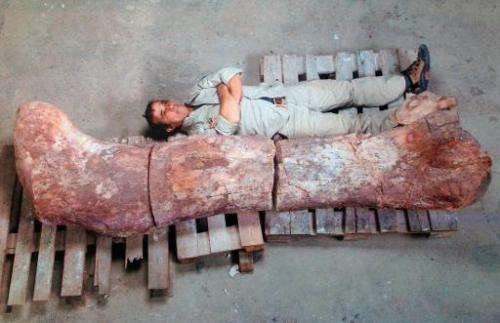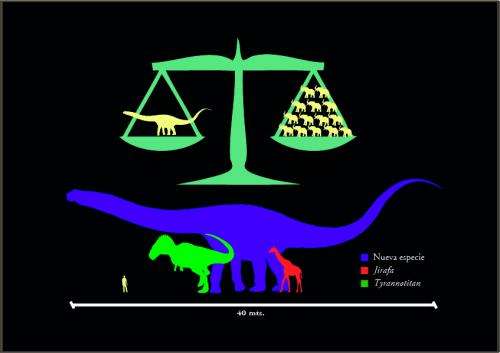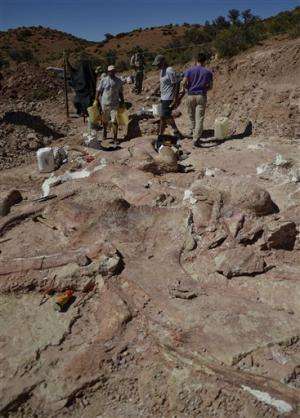Fossils of 'largest' dinosaur found in Argentina (Update)

Paleontologists in Argentina's remote Patagonia region have discovered fossils of what may be the largest dinosaur ever, amid a vast cache of fossils that could shed light on prehistoric life.
The creature is believed to be a new species of Titanosaur, a long-necked, long-tailed sauropod that walked on four legs and lived some 90 million years ago in the Cretaceous Period.
Researchers say the plant-eating dinosaur weighed the equivalent of more than 14 African elephants, or about 100 tonnes, and stretched up to 40 meters (130 feet) in length.
The previous record holder, also in Argentina, the Argentinosaurus, was estimated to measure 36.6 meters long.
A fossilized femur of the Titanosaur was larger than a paleontologist who lay next to it.
And the find didn't stop there.
Bones from at least seven individual dinosaurs, including some believed to be younger, were found at the site.
This is "the most complete discovery of this type of giant dinosaur in the world, a momentous discovery for science," cheered Jose Luis Carballido, one of eight scientists who participated in the research.
The fossils were accidentally discovered in 2011 by a farm worker in a remote area in the Patagonian province of Chubut, some 1,300 kilometers (800 miles) south of Buenos Aires.
The worker first spotted a massive leg bone, measuring some 2.4 meters in length.
Excavations launched in January 2013 also uncovered complete bones of the tail, torso and neck—which will allow for a fuller picture of what the entire animal looked like when alive.
Carballido, part of a team of Argentine and Spanish researchers, said the group had uncovered "10 vertebrae of the torso, 40 from the tail, parts of the neck and complete legs."

"Until now, what was known, worldwide, about sauropods was from fragmentary discoveries," said the 36-year-old paleontologist from the Egidio Feruglio Museum in the southern city of Trelew, calling the find "extraordinary."
Tip of the iceberg
Even more bones may yet appear.
So far, "we have only recovered an estimated 20 percent of what's in the field," said Carballido.
The find is set to help shed light on more than just the anatomy of these remarkably large herbivores.
The researchers have also found what they believe to be muscle insertions, which will help them reconstruct the form of the creature's muscles and calculate how much energy was needed to move them.
Paleontologists have found about 60 teeth at the site, 57 of which are from Tyrannotitan carnivores—one of the largest known therapods, and known scavengers.

In addition to the skeletal remains, fossil imprints of leaves and stems have been found, which could help researchers rebuild the ecosystem at the time.
"We will be able to make a very precise reconstruction and answer many questions," Carballido said—including just what about southern Argentina made conditions favorable for so many massive dinosaur species.
'A treasure trove'
So far, the new species remains unnamed, and scientists estimate they will publish the first results next year.
"The research will be done in several stages. First we will present the new species, its characteristics," Carballido said, followed by years of study to detail the animal's biology and "the way it grew up."
Paul Barrett, fossils and anthropology expert at London's Natural History Museum, cautioned that claims this dinosaur is the largest ever still must be confirmed.
"This is an inspiring new discovery of a truly gigantic dinosaur," Barrett said.
"However, we need to know more about the overall size and proportions of the skeleton and use several different methods to investigate its possible width before deciding it's definitely the largest dinosaur species yet known."
US paleontologist David Burnham agreed that "a lot of things still need to be proven."
But largest dinosaur or not, the breadth of the discovery was truly remarkable.
"You can really start reconstructing past life when you get a treasure trove like this," said Burnham, of the University of Kansas.
Finding so many individual dinosaurs at one site could confirm the hypothesis that these herbivores lived in herds, as well as determine any predators they may have had, whether they were scavengers, when they died and in what type of environment they lived, the paleontologist added.
More information: MEF: www.mef.org.ar/index.php?optio … 1&Itemid=152&lang=es
© 2014 AFP





















